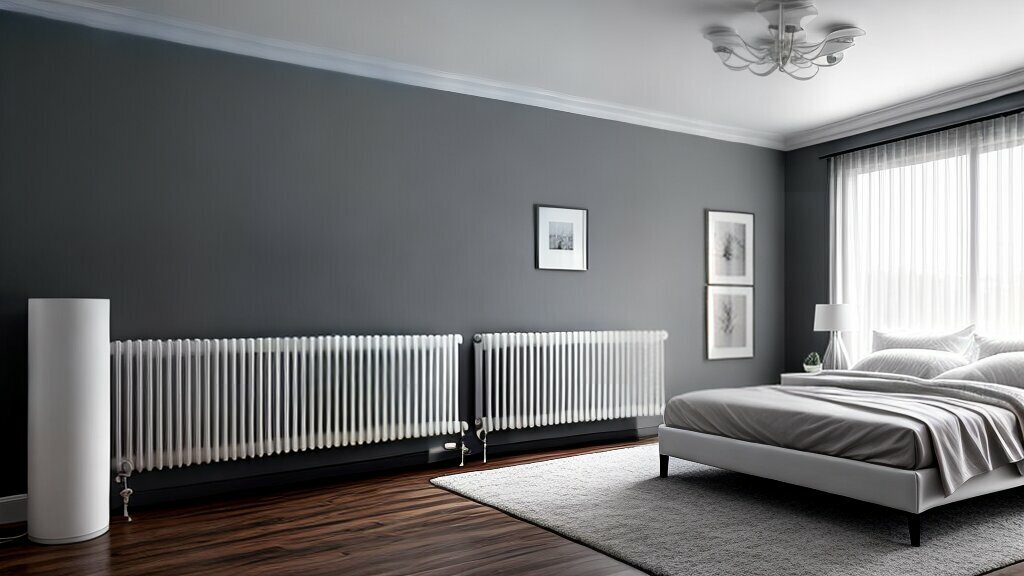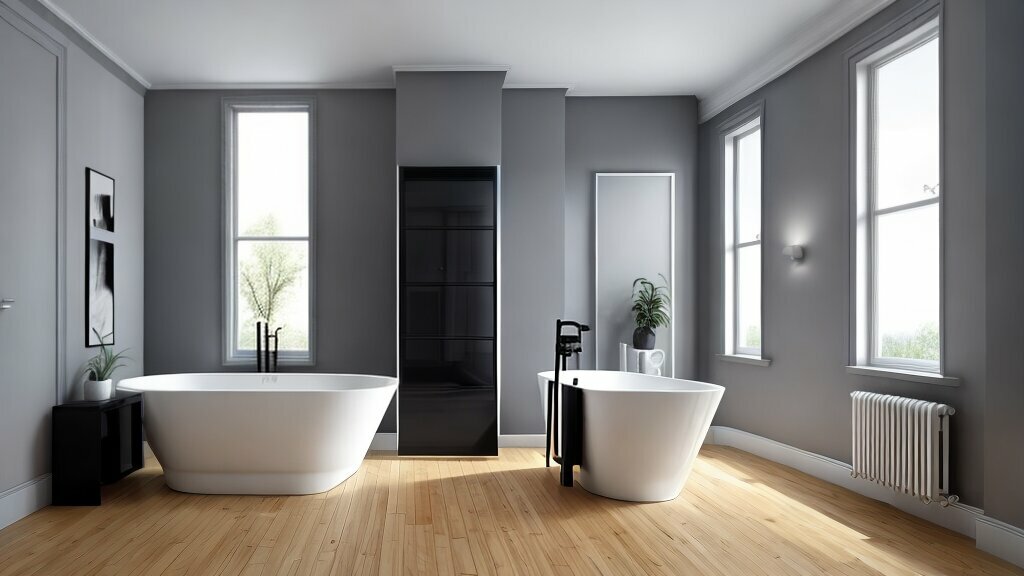Radiators: How to- The Best Heating Types, and Benefits

How to – The Best Heating Types Radiators
Radiators are an integral yet often overlooked part of most modern homes. These familiar metal fixtures mounted on walls and between windows provide essential heating and warmth, allowing us to comfortably inhabit spaces even during the coldest months.
Beyond their functional purpose, radiators have become design statements in their own right. From sleek minimalist panels to decorative cast iron models, they contribute greatly to the aesthetic of both classic and contemporary interiors.
This comprehensive guide aims to explore the breadth of the radiator world. We’ll examine the history and evolution of radiator technology, the different types available today, and how to select the right model for your needs. We’ll also dive into proper installation, maintenance, operation, accessories, innovations, and even tackle some common radiator problems and solutions.
Whether you’re looking to upgrade old models in your home or learn more about how these deceivingly simple devices work, this guide will equip you with complete radiator knowledge.
A Brief History of Radiators

While radiators may seem like a commonplace modern convenience, they have a long and storied past. The genesis of heating devices using circulated hot water and convection dates back all the way to the early Romans!
By the 1800s, primitive central heating systems with early radiator-like devices began emerging in larger buildings in cold climate regions. However, it wasn’t until the mid-late 1800s that hot water heating gained widespread adoption in modern homes.
Early home radiators were bulky and incredibly inefficient by today’s standards. Most featured heavy cast iron constructions mounted below windows.
Throughout the 1900s, rapid advancements revolutionized home heating. Lighter and more efficient steel and aluminum radiators gained prominence by the 1950s and 60s. More precise welding and construction techniques also improved performance.
The past decades have seen an explosion in aesthetically-oriented designer radiators featuring unique shapes and finishes. As energy efficiency becomes a larger concern, the latest innovations focus on improved smart controls and integrating radiant heating into floors and walls.
Main Types of Radiators
With centuries of innovation behind them, radiators have diversified greatly. Here are some of the most common modern radiator types and their distinguishing features:
Central Heating Radiators
The most ubiquitous variety, central heating radiators use circulated hot water from a home boiler/furnace heating system. This includes common panel, column, and old-fashioned sectional radiators. They come in a diverse range of sizes, shapes, finishes and heat outputs to integrate seamlessly into any room.
Electric Radiators
Electric radiators heat up via internal electrical heating elements instead of hot water circulation. They can provide targeted heating in spaces lacking central heating ductwork or pipes. Most electric models feature onboard thermostats and timers for precise control.
Designer Radiators
Designer radiators prioritize aesthetics alongside functionality. They come in literally thousands of styles featuring unique curved shapes, decorative covers, customizable finishes and more. Popular varieties include column, panel, and geometric pattern radiators made from metals and even glass.
Towel Radiators
Towel radiators provide a convenient way to warm towels in bathrooms. Their horizontally oriented heated tubes or bars allow towels to be draped over them to dry and warm up. They’re often paired with electric central heating radiators for maximum heating capacity.
Other Varieties
Beyond the common home radiators described above, specialized varieties have also been designed for niche applications:
- Steam heating radiators for commercial/industrial applications
- Compact low temperature radiators for applications like underfloor home heating
- Double & triple panel extra capacity radiators for larger/poorly insulated spaces
Radiator Materials
The choice of underlying material greatly affects radiator performance and longevity. Here’s an overview of the most common materials and their distinguishing properties:
Cast Iron
- Known for exceptional heat retention abilities
- Very heavy & rugged – resists damage
- Slow to heat up but retains warmth for hours
- Prone to corrosion if not properly treated
- Often used in antique/traditional decorative rad models
Steel
- Lightweight yet durable metal construction
- Heats up swiftly and offers good heat conduction
- Available enamel coated to improve corrosion resistance
- Cost-effective option suitable for most spaces
- By far the most common modern radiator material
Aluminum
- Incredibly light construction
- Rapid heating response – no waiting around for heat
- Resists corrosion through oxidization properties
- Great conductivity allows for smaller sizes/heat outputs
- More expensive than steel but unparalleled efficiency
Other Exotic Materials
- Copper: Excellent heat transfer properties but very expensive
- Glass: Unique transparent designer radiators for modern interiors
- Stone: Integrates with natural stone wall finishes
How Do Radiators Actually Work?
While radiators may seem like inert chunks of metal, there’s actually an elegant heat transfer dance occurring within them. This physics bilevel romance enables them to heat up spaces.
Convection Heating
The primary means of heat transfer occurs through forced air convection currents. As the radiator heats up, either through hot water flow or internal electric elements, the metal surface gets hot. Air molecules directly touching the surface absorb this heat energy. As they gain heat, they become less dense, rise and are replaced by cooler air molecules which then also heat. This creates a constant convection current, circulating warm air to the rest of the room.
Radiative Heating
Simultaneously, radiators also transmit infrared electromagnetic radiation directly to objects within line of sight. As these infrared rays strike nearby walls, floors, furniture and even people – they impart thermal heat energy. This radiation combines with rising convection currents to heat up spaces.
The dual-action convective and radiative heating powers enable even smallish radiators to heat surprisingly large, well-insulated spaces.
How to Select the Right Radiator
With so many types, materials and heat outputs available – selecting the ideal radiator for your space might seem daunting. However, just keep the following key factors in mind:
Room/Space Size
Choose a radiator with adequate surface area and heat output capacity (BTUs) for the room it is intended to heat. Undersizing can lead to cold spots and comfort issues.
Heat Requirements
Consider the overall heating needs and characteristics of the space. Spaces exposed to cold outdoor conditions require more heating power than interior rooms. Prioritize higher BTU models with faster heat up times for these applications.
Placement/Installation Factors
Think about optimum placement on colder exterior walls and sufficient clearance for installs and maintenance access. This might dictate longer narrow column radiators over more compact squares.
Style & Decor
Radiators have become as much about interior style as heating. Select designer models featuring shapes, colors and finishes complementing your existing room decor.
Radiator Installation & Maintenance
Getting professional radiator installation is highly recommended, especially for first timers. However, some basic maintenance tasks are approachable DIY projects.
Installation
Radiator positioning requires careful measurement of available wall space, clearance from windows/doors and distance to heating system connections. Most models mount on supplied brackets attached to the wall.
All connections should include thermostatic valves to enable precise temperature control of each radiator individually via a thermostat head. Open up supply and return valves slowly post-install to purge any air and confirm water flows smoothly.
Maintenance
- Bleeding: This involves manually purging trapped air inside which can reduce heat transfer. Special bleeder valves on radiators allow easy bleeding.
- Cleaning: Gently wipe down radiator exteriors periodically using soft cloth and mild detergent to maintain appearance. Use radiator specific cleaners instead of abrasives.
- Painting: Special high temperature paints are available to refresh the look of older radiators. Scuff sand before application and properly cure the paint.
- Corrosion Control: Touch up chips/flakes in enamel coatings to prevent corrosion on steel radiators. Anodizing protects aluminum models from surface oxidation.
Energy Efficiency & Running Costs
Radiators have come a long way from early inefficient cast iron beasts. The latest models feature optimized materials and clever designs for superior efficiency:
- Smaller sizes: Improved heat conduction of aluminum and steel allows smaller radiators to heat similar spaces.
- Faster response: Reduced thermal inertia from lightweight materials enables faster heating and cooling. Use less energy getting to temperature.
- Lower water volumes: Compact heat exchanger panels and fins require less water volume inside radiators. Less thermal mass to heat first.
- Smart controls: Programmable thermostatic valves and room sensors only turn on heating when truly needed.
When combined with a high efficiency boiler, total system running costs can be greatly reduced compared to older heating setups.
Radiator Safety Tips
While radiators pose minimal risks when installed correctly, adherence to basic safety common sense helps prevent accidents:
- Avoid direct skin contact with hot surfaces to prevent burns
- Supervise children around hot radiators and teach safety
- Allow sufficient airflow clearance around units
- Install guards/covers over exposed piping to prevent scalding contact
- Ensure professional installs with properly tested pipes and connections
- Use integrated thermostatic valves to automatically regulate temperatures
Exciting Radiator Technology Innovations
Even after 200+ years of refinements, engineers and designers continue finding ways to improve humble radiators via integration of new technologies:
Smart Radiators
The latest models incorporate wifi/bluetooth connectivity for app and voice activated remote control. Monitor heating status and customize schedules from your smartphone based on occupancy and usage patterns.
Eco-Friendly Materials
Several companies now offer radiators constructed from recycled aluminum and steel. These maintain efficiency credentials of new metal but with far smaller carbon footprint.
Hybrid Radiant Heating
Instead of forced air convection, hybrid systems leverage radiant heating from walls and floors. Warm objects instead of warming air directly. Combining this tech with lower temperature water supplies improves comfort and efficiency.
Customizability
Modern manufacturing methods now enable fully customizable radiators. Choose unique color finishes, engrave custom names/patterns and adjust sizes to fit any space constraints.
Troubleshooting Common Radiator Problems
While modern radiators are generally reliable, several common issues can arise over their service lifespan:
Uneven Heating
If sections or sides of the radiator aren’t heating uniformly, this usually indicates trapped air interfering with hot water circulation. Try the “bleeding” process to purge any bubbles and recheck. Ensure proper alignment and level installation.
Metallic Noises
Clanking or metallic noises during heating/cooling cycles can occur as internal metal parts expand and contract. Remove and inspect connections. Replace damaged gaskets, valves or elbow fittings if necessary.
Leaks
Small leaks might only show up as external drips during heating stages. Immediately consult a heating specialist to identify and seal any cracks or malfunctioning valves before major leaks develop.
Reduced Heat Output
A gradual drop in heating capacity over time is normal as parts wear out. But a sudden loss may indicate internal sludge or corrosion build up impeding waterways. Flush the radiator and heating system to restore normal flows.
Helpful Radiator Accessories
A variety of accessories are available to further improve radiator functionality:
These smart self-regulating valves attach onto supply/return piping connections. Integrated temperature sensors open or close based on the set temperature to eliminate manual adjustment and save energy.
Isolation Valves
Isolation valves completely shut off water supply to individual radiators. This allows servicing one unit without shutting down the entire system. It also enables turning off unused rooms.
Vents & Air Bleeds
Automatic air vents and bleeder valves allow self-purging of trapped internal air bubbles which can reduce heat transfer if allowed to accumulate.
Guards & Screens
Perforated sheet metal guards and screens mounted over the radiator prevent direct contact while allowing airflow. This improves child safety while permitting convection heating currents.
Shelves & Racks
Installing shelves over wall mounted radiators creates useful display space without impacting heating effectiveness. Just ensure adequate vertical clearance for convection. Some even integrate clever towel drying racks.
Getting UK Government Help to Heat Your Home
Heating old, inefficient homes through icy winters can be prohibitively expensive. Thankfully, the UK government offers several grant programs to help households struggling with high energy bills.
Home Upgrade Grants
These grants provide funding to install insulation, upgrade aging boilers and make other energy efficiency improvements. You can receive up to £10,000+ in grant support based on household income eligibility and recommended upgrade packages. It allows turning drafty rooms into cosier spaces for a fraction of the cost.
Renewable Heat Incentive
To encourage greener heating, subsidies under this program incentivise switching from fossil fuels to renewable sources. Options like heat pumps, solar thermal and biomass boilers earn quarterly payments over 7 years based on the estimated heat generated. This covers the high upfront costs over time.
Energy Company Obligation
Major UK energy suppliers fund insulation and heating improvements under this initiative. Qualifying low-income and vulnerable households get upgrades like efficient gas boiler replacements done free of charge. The energy company arranges required installations by certified technicians.
Local Authority Grants
Many councils provide their own seasonal fuel grants, heating upgrades assistance and emergency funds. Support offerings differ across boroughs. Check if special hardship funds or insulation drives are available locally to supplement national programs.
Don’t endure cold indoor temperatures and astronomical bills simply because upgrades seem unaffordable. With the right government grant support, keeping your home warm and cosy is possible. See if you qualify today.
Final Thoughts
Although often overlooked as mere functional fixtures, radiators have a rich and fascinating history. The many types and variety of styles available means they can enhance both comfort and interior decors.
By understanding key operating principles and selecting the right size, style and accessories – radiators can provide reliable heating with minimal fuss. And with exciting new technologies and materials, they will undoubtedly continue evolving in homes for the foreseeable future



